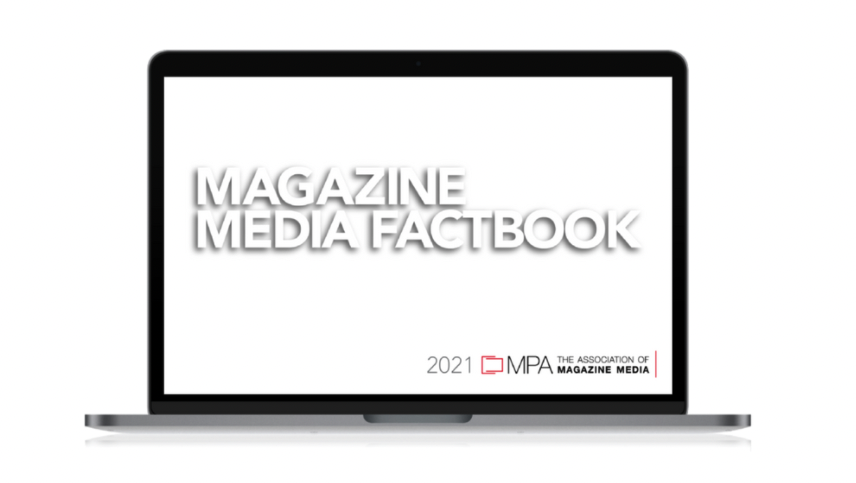US MPA launches Media Factbook 2021
MPA – The Magazine Media Association in the US, and FIPP member, today launches the 2021 edition of its Media Factbook, a go-to resource on the effectiveness of the magazine media industry in the US. The comprehensive, 100-page report surveys a transformational 12 months for magazine media, offering data and analysis on all areas of the industry from sustainability to its relationship with advertising.
Here are some of the key takeaways from the Media Factbook 2021.
Magazines are going strong
First and perhaps most importantly, the fact that 88 per cent of US adults report having read a magazine (print or digital) in the last six months, including 90 per cent of under-25s, speaks to the ubiquity and endurance of the form. Female readers in particular turned to magazines more than ever during the pandemic, including one third of millennial women.
Reader engagement deepens
Like previous editions, this year’s report emphasises that reader engagement is consistently higher when it comes to magazine media, compared to the internet and television. In fact, the top 25 magazines in the US reach more adults than the top 25 primetime TV shows.
This was magnified by the early impacts of Covid-19, which led people to seek credible, well-curated content in which they could take comfort. Not only do readers find magazines more trustworthy, life-enhancing and inspiring, this also translates to higher engagement with ads.
MPA Webinar: The launch of MPA’s 2021 Magazine Media Factbook
Thursday 23 September, 4pm Eastern Time
Join Britta Cleveland, SVP of Research Solutions at Meredith Corporation and Kelly Augustine, Director of Insights at MRI-Simmons as they discuss the key research, themes, and storylines in this year’s edition. Sign up here.
Print is good for advertisers …
Some 64 percent of Americans aged 18 to 34 say that, even in the digital age, they love the touch and feel of a printed magazine. Many studies have shown that the way we use electronic devices now tends to overwhelm our thinking capacities, resulting in an overtaxed mind that is more susceptible to distraction. Printed magazines, on the other hand, encourage a calmness in the reader, driving sensory involvement and resulting in higher rates of recall and comprehension.
This all means that print ads consistently score more highly than digital ads in growing consumer awareness and ensuring intent to act. Some 53 per cent of adults aged 18-49 say ads in magazines fit well with the content, more than other media, and of those who noted an ad in print, the majority (68 per cent) took some kind of action upon seeing it – whether visiting a product’s website, recommending it to a friend, or cutting out and saving it.
… But it’s even better when combined with web advertising
Across all age groups, engagement with both a print magazine ad and a corresponding ad on the magazine’s website increased ad efficacy, a combination that drives greater stopping power and actions taken.
For example in the 35-54 age bracket, of the 67 per cent of women who noticed a skincare ad in print and online, 56 per cent took some kind of action. This is a notably better ratio than for print only, in which 27 per cent of the 55 per cent who saw the ad were driven to act.

For countless more stats and insights, download your copy of the full MPA Media Factbook 2021 here. You can also read your copy in the PressReader platform, here.
Diverse readership
MPA’s research shows that magazines also reach diverse audiences. Compared to the US adult average of reading 4.5 print magazine issues per month, Black/African-American (5.7), Hispanic-American (4.6), and LGBT+ (4.8) adults exceed that, with Asian-American adults reading 3.9 print magazine issues per month – close to the average.
Potential to reach secondary audiences
The 2021 Factbook also shows the slow-burning power of magazines. Nearly a quarter of women said they keep hold of old copies, and readership continues to grow beyond publication date, meaning that there are more opportunities for engagement further down the line.
Social media growth across the board
It’s also been a good year for magazines’ social media presence. Consumers are shown to enjoy the bite-size version of magazine brands that they engage with on social media. The 2021 Factbook shows that, according to CrowdTangle, magazine brands captured 697m likes and/or followers across Facebook and Instagram in the past year.
Facebook continues to attract the largest number of likes (427m) and Instagram had steady growth – increasing +16 per cent year on year to reach 270m magazine industry followers.
Magazine readers like to be ahead of the curve
In general, devoted magazine readers – those who read print magazines several times per week or digital magazines more than once per day – tend to be active learners seeking new experiences. Fifty-nine per cent of such readers indicate that they like to stay up to date on the latest book releases, more than devoted radio listeners (42 per cent) as well as devoted internet (29 per cent) or TV users (31 per cent).
More than half (51 percent) of devoted magazine readers also report that they like to read books before everyone else does and, along with devoted radio listeners, score more highly than other types of devoted users on self-reported openness to change and being the first among friends to try new tech products and services.
Affluent magazine readers want to travel
As the strictest Covid-19 lockdowns ease in rich countries with high vaccination rates, affluent magazine readers in the US are looking forward to travelling domestically and internationally, mostly to Hawaii, Florida, or on a cruise. More than any other medium, including social media, magazine readers are inspired by what they have read about and this correlates with being “very likely” or “somewhat likely” to take a holiday in the next year.
Furthermore, affluent magazine readers are more likely to purchase second homes and appliances, pay for premium high-end décor, and be more actively engaged with wider trends in society.
For countless more stats and insights, download your copy of the full MPA Media Factbook 2021 here. You can also read your copy in the PressReader platform, here.











